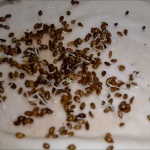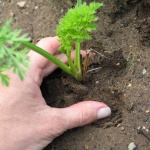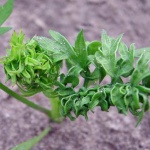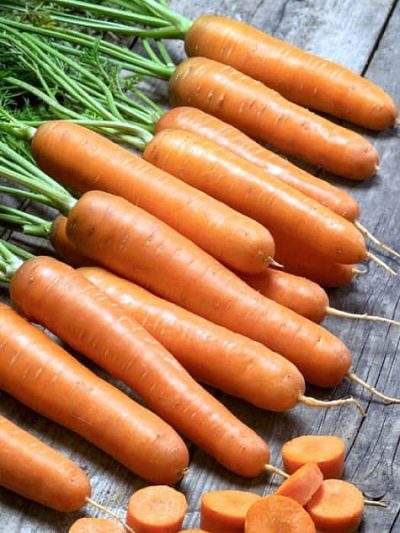
- Name synonyms: Laguna
- Year of approval: 2007
- Appointment: for fresh consumption, for canning, for bundled products
- Leaf rosette shape: semi-spreading
- Leaves: medium, green, fine to medium dissected
- Weight, g: 80-130
- The form : fusiform with blunt tip
- Taste qualities: good ones
- Composition : dry matter 10.1-13.8%, total sugar 5.0-7.3%, carotene up to 17.2 mg per 100 g of raw matter
- Ripening terms: early
The Laguna carrot is a fast-ripening hybrid, ideal for regions with short summers. The culture not only manages to fully mature, but also accumulate the required amount of useful microelements.
Breeding history
The hybrid was created by Dutch breeders. It was entered into the State Register of the Russian Federation in 2007.
Description of the variety
The lagoon has a number of significant advantages:
early harvest;
high-yielding variety;
friendly germination of seeds;
resistance to most diseases;
high indicators of marketability - 70-91%;
the possibility of using for winter sowing.
Among the shortcomings, one can single out a high requirement for the composition of the soil and a short shelf life of the harvested root crops.
Characteristics of the appearance of the plant and root crops
The leaves are of medium size, finely and medium dissected, with a rich green color. The rosette of leaves is semi-spreading. The average length of carrots is 14-16 cm and weighing 80-130 grams. The root vegetable is fusiform with a blunt tip. The color of the skin and pith is orange. The surface is smooth and even. The core of the fruit is very small or completely absent.
Purpose and taste of tubers
Juicy and crunchy, the flesh tastes sweet. Per 100 g of raw matter: dry matter 10.1-13.8%, total sugar 5.0-7.3%, carotene up to 17.2 mg.
Carrots can be eaten fresh, frozen, juiced, used for various preserves. A universal purpose in the preparation of all kinds of dishes.
Maturation
Early ripening of fruits. It takes 60-65 days from seed germination to harvest.
Yield
Yield indicators are consistently high. On average, from 1 hectare, you can get 186-316 centners. The yield is strongly influenced by the temperature indicator. After seed germination, the temperature should not drop below +10 degrees.
Growing regions
Carrots can be grown almost throughout the country, regardless of climatic zones. The variety shows the best yield indicators in regions with a temperate climate, namely: in the North Caucasus.
Growing and care
Before planting Laguna carrots on your site, it is necessary to carry out pre-planting work, which consists in preparing seeds and soil, observing planting dates and crop rotation rules.
As a rule, manufacturers pre-treat the seeds with special preparations that protect the seed from diseases and pests, but if you are not sure of this, you can prepare the seeds yourself. To do this, they are first sorted by size, the damaged ones are removed, disinfected in a weak solution of potassium permanganate, left for a day in a damp cloth in the refrigerator for hardening.
This hybrid is quite picky about the composition of the soil. It prefers to grow on clay-sandy soils with an acidity level of 6-6.5 pH. It grows well on peat bogs. The soil is prepared 2 weeks before sowing.Carefully dig up shovels on the bayonet, remove weeds, apply mineral fertilizers, then dig everything thoroughly again.
The sunniest area is chosen for the culture, with a slight elevation so that there is no stagnation of liquid, especially in spring, during the period of active snow melting.
And also the crop rotation should be taken into account. Carrots grow well after potatoes, tomatoes, cucumbers, courgettes, legumes, cabbage, onions, garlic and herbs. In turn, you should not plant Lagoon after parsley, dill, cumin, beets and celery, since they have similar pathogens.
They start planting from April to May, adhering to the scheme of 5-7 cm between seeds and 15 cm between rows. Despite the fact that the hybrid is unpretentious in care, in order to get a good harvest, you need to observe some peculiarities in cultivation.
Carrots are hygrophilous culture, so irrigation is carried out regularly and abundantly, but trying not to overmoisten the soil excessively. Watering is carried out in the evening, after the decline in solar activity.
It is necessary to timely weed the beds from weeds, which negatively affect the development of the variety. Loosening additionally saturates the soil with oxygen. Additional food begins to be introduced one month after planting. Sodium and potassium prevent the development of rot on vegetables, which can develop due to improper watering. Further, the plant is fed with organic matter, humus, which provides the culture with the necessary nutrients.
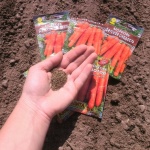
Carrots are one of the most unpretentious crops in terms of growing conditions; they can endure a short drought and a short cold snap. However, to get tasty and large root crops, you should adhere to the basic rules for planting carrots.
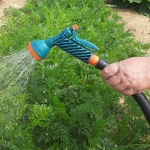


Carrots grow in almost any garden. There is an opinion that this culture is very resistant to all kinds of diseases and pests, but this is not the case. Without proper care, carrots become susceptible to all kinds of infections and are affected by harmful insects.


